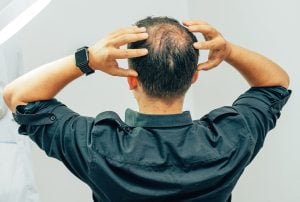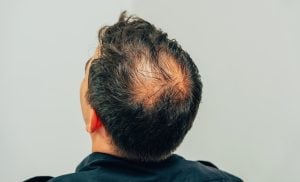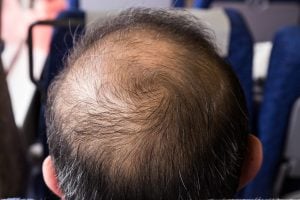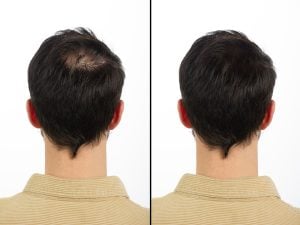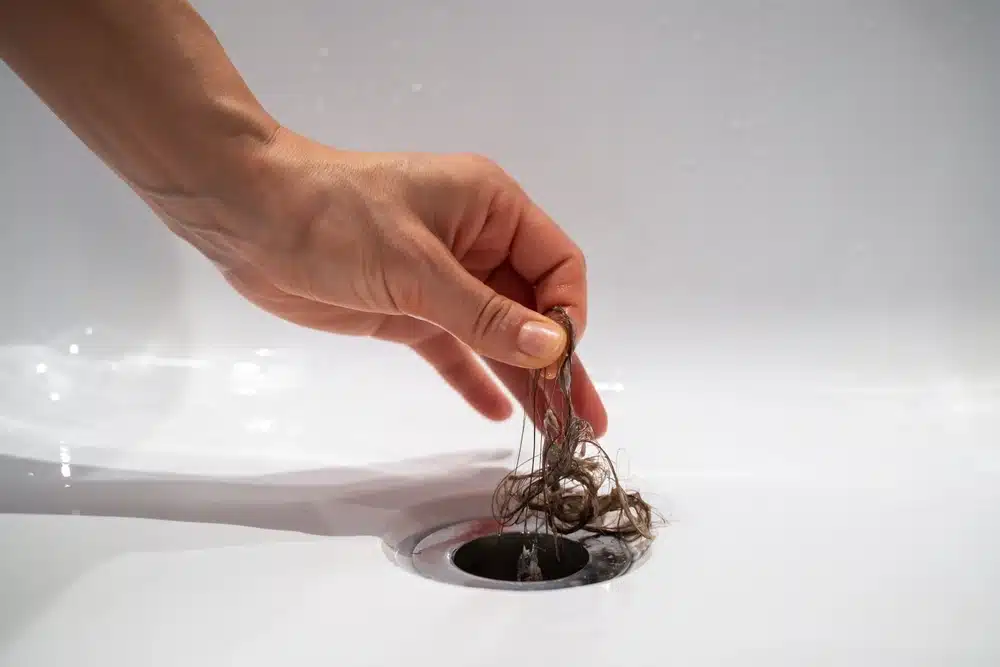At some point or another, most men look carefully at their hairline to see if there’s any sign of thinning. What about the back? You can’t easily see the crown of your head when looking in the mirror, but this is one of the most common areas to lose hair.
What is Crown Hair Loss?
Crown hair loss simply means the loss of thinning of hair at the crown. It typically happens in men as they age and is one of the most common areas in general for people to lose their hair. The level of hair crown balding can differ significantly from person to person, from minimal hair thinning to a large bald spot on the crown.
Where is the Crown of Your Head?
The crown of your head is at the back of your scalp at the very highest point. It’s the very centre of the scalp.
Can Crown Baldness Affect Women?
Yes. While crown hair loss is more common in men, many women experience it. The most common causes of crown balding in women are alopecia areata (which also affects men) and female pattern hair loss.
How to Spot Crown Thinning
There are different crown balding stages, some more noticeable than others. Crown thinning will often be accompanied by a receding hairline, so it’s good to check the crown of your head if you’re experiencing that. You can check if your crown has thinning hair by holding a mirror to the back of your head. You could also ask a loved one to check for you. If you notice thinning hair or a bald patch, that’s a sign of crown hair loss.
The Causes of Crown Hair Loss
There are many causes of this type of hair loss, with things like genetics, hormonal changes, nutritional deficiencies, and stress all potentially playing a role. Here are some of the most common causes of a crown going bald.
Alopecia Areata
Alopecia areata is a fairly common disease that causes hair loss. The symptoms of alopecia areata include multiple bald patches, sudden hair loss, and body hair loss.
Traction Alopecia
Traction alopecia affects roots that have been pulled on too much, perhaps due to a tight hairstyle.
Male Pattern Baldness
Male pattern baldness is a very common cause of hair loss (including on the crown), affecting up to 50% of men by the time they reach 50 years of age. It’s a dermatological condition and typically happens because of changes to the male sex hormones and genetics.
Female Pattern Baldness
Female pattern baldness is not as common as male pattern baldness. Much like male pattern baldness, it’s typically caused by hormonal imbalances and genetics.
Medications
Certain medications can cause hair loss, including antifungal medications, antidepressants, and beta-blockers.
Trauma
Experiencing trauma to the crown of the head can damage hair follicles, leading to the loss of hair.
Nutritional Deficiencies
Some nutritional deficiencies can cause hair loss in both men and women, including deficiencies in zinc, iron, vitamin D, and vitamin C.
If you experience crown thinning, it’s important to get to the root cause to determine the best type of treatment for you. Consulting a medical professional is the best option here.
Does Crown Hair Loss Always Mean You’ll Go Bald?
Experiencing crown thinning is always going to worry you, especially if you have early crown hair loss. However, it does not always mean you are going to go bald. Still, it’s important to take preventative measures as soon as you notice the signs of thinning hair on the crown.
Is Crown Hair Loss Treatable?
There are certain steps you can take to reduce the chances of experiencing crown thinning. Of course, how effective those steps are depends on the cause of the crown balding and the level it is at. For example, it’s easier to treat slight hair thinning with medications than to reverse a large bald patch. The most effective form of treatment is a hair transplant, which will completely restore hair to the affected area. For early crown hair loss, less invasive treatments like Minoxidil might work better.
How to Prevent and Deal with Crown Hair Loss
While on the surface, crown thinning is not medically serious, it can have a lot of negative psychological effects on a person. It can harm your self-image and lead to increased anxiety. By taking action to restore your hair, you can gain your confidence back. Luckily, there are plenty of different ways to prevent and deal with a crown bald spot, and the one that works for you depends on your case.
Use Medical Treatments (Minoxidil, Finasteride, and Dutasteride)
There are certain medical treatments that help restore hair loss. One of the most popular and effective treatments is Minoxidil. You use it topically on a bald patch to help restore the hair to the area. It works by stimulating hair growth by increasing blood flow, reversing the damage caused, and boosting hair growth. Other medical treatments include Dutasteride, an oral medicine that helps produce the hormone DHT. It’s very effective for male pattern baldness.
Eat a Nutritious Diet
There is a strong link between nutrition and hair loss, with particular deficiencies disrupting the normal hair growth cycle. If the cause of your hair loss is caused by a nutritional deficiency, it’s a good idea to address that by a change of diet or taking vitamins. You can usually get tested for nutritional deficiencies by getting your blood work done at the doctor’s office.
Minimise Stress
If you have noticed a crown bald spot after a period of stress in your life, then the stress might be the root cause of it. While it’s often easier said than done, reducing stress levels can help prevent further hair loss. Some useful stress management techniques include exercise, meditation, yoga, and talking therapies. Speaking to a medical professional might be best if your stress levels are very high.
Be Mindful when Grooming
Too much pulling, combing, and heating the hair will cause damage over time, with some grooming practices even resulting in a bald patch on the crown. It’s best to minimise your use of heat and avoid wearing hairstyles that pull too much at the root of the hair.
Change Your Hairstyle
If your crown hair loss is minimal, simply switching your style to a crown bald haircut can make a world of difference. Some of the best haircuts to hide a crown going bald include the buzz cut, crew cut, and faux hawk. Generally, a shorter cut will look better and help make the hair loss less noticeable. Your hairdresser will be able to help you figure out the best style for you.
Get a Hair Transplant
Simply put, a hair transplant is a surgery that involves taking healthy hair follicles from one section of the head (that hasn’t experienced balding) and placing them into the thinning/balding area. You can get it for crown hair thinning as well as thinning in other parts of the scalp (such as the hairline). There are different types of hair transplants, with the FUE hair transplant being an excellent option. If you’re thinking about getting a hair transplant, this hair graft calculator can help you see how many hair grafts you will need (and, in turn, the average cost of the procedure).
Early crown balding stages tend not to require surgery to restore the hair, so if your hair loss is quite minimal, something like Minoxidil or even just managing your everyday stress can have a positive impact on your locks. However, if your hair loss is quite severe and medical treatments don’t seem to work, a hair transplant is the best route to restore both the hair and your confidence.
Is Hair Restoration Right for You?
Getting a hair transplant is not usually the first treatment for people with a crown bald spot – especially if the bald patch is brand new and very small. However, there are certain instances where a hair transplant makes the most sense. If the following rings true for you, you may be an excellent candidate for this hair restoration surgery:
- You’re at least 25 years of age
- Hair loss medications have not worked for you
- You’ve done research into hair transplants
- You have sections of healthy hair
- Your hair loss is hereditary
- Your hair loss is causing a lack of confidence
Many people have found an incredible solution in the form of hair transplant surgery – it’s not something only for the rich and famous. Plus, the latest technologies mean the surgery is as minimally invasive as possible while leaving little scarring.
Book a Consultation Today
Here at Harley Street Hair Clinic, we have a team of top surgeons delivering outstanding results via hair transplant surgery. If you want to start your hair restoration journey, book a consultation today. We also have a brilliant hair track app that allows you to understand your hair loss and schedule consultations with the best doctors around.
Sources:

